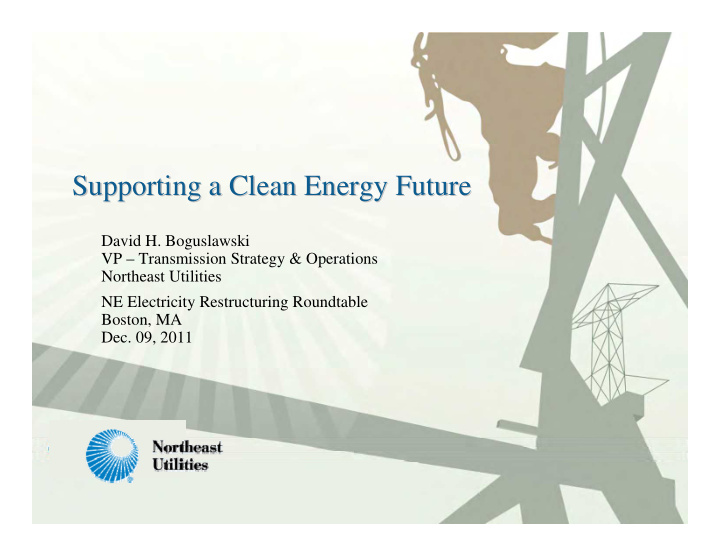



Supporting a Clean Energy Future Supporting a Clean Energy Future David H. Boguslawski VP – Transmission Strategy & Operations Northeast Utilities NE Electricity Restructuring Roundtable Boston, MA Dec. 09, 2011 1
A comprehensive approach is needed to meet New A comprehensive approach is needed to meet New England’ ’s s RPS RPS and carbon goals and carbon goals England New England’ ’s goals increase s goals increase Closing the gap will require a New England Closing the gap will require a over time 3- -part approach part approach over time 3 25,000 Class I 1. Managing consumption Renewable Goals 20,000 Gigawatt Hours (GWh) 15,000 2. Importing clean, Gap economic power 10,000 3. Building domestic 5,000 renewable Existing Class 1 Renewables resources and the 0 enabling transmission 2009 2013 2017 2020 2
The Northern Pass Project - - Description Description The Northern Pass Project • Delivers enough renewable, low-carbon energy to power 1 million homes 1,200 MW HVDC Line 1,200 MW HVDC Line from Hydro- Quebec from Hydro- Quebec • US segment owned jointly by NU and to central NH to central NH NSTAR • Quebec segment owned by HQ- TransEnergie • Transmission cost-based rates using a “participant pays” model – Revenue requirements paid for by Hydro-Quebec US AC line from AC line from central NH to NE – Transmission rights assigned to central NH to NE transmission grid Hydro-Quebec US transmission grid • Operation by ISO-New England • Target in-service date is 2016 3
The Northern Pass Project - - Schedule Schedule The Northern Pass Project May 2009 FERC approval of Project structure Dec 2009 FERC Order on rehearing requests Oct 2010 Executed Transmission Service Agreement with HQ Hydro Renewable Energy Oct 2010 DOE Presidential Permit application Feb 2011 FERC approves transmission service agreement Mar 2011 DOE holds 7 scoping meetings in NH Jun 2011 U.S. Forest Service application 2012-2013 DOE permitting process 2012-2013 ACOE permitting process 2012-2013 New Hampshire permitting process (Site Evaluation Committee) 2014-2016 Proposed construction Ongoing outreach efforts = Completed 4
The Northern Pass Project - - Benefits Benefits The Northern Pass Project Economic Benefits • Annual New England energy savings of $200 - $325 million • Creates 1,200 jobs • Provides $22 - $27 million in annual taxes Environmental Benefits • Reduces carbon dioxide emissions up to 5 million tons a year • Complements the development and operation of local renewable resources Reliability Benefits • Provides new capacity • Increases fuel diversity (not natural gas) 5
New England’ ’s s RPS RPS gap is large and growing gap is large and growing New England Potential Gap = 12,700 GWh 25,000 “Demand” for Class I Renewables 20,000 Gigawatt Hours (GWh) The Problem (Additional need) 15,000 10,000 Surplus Renewables in ISO Queue at 30%* 5,000 Likely (Existing) 0 2009 2013 2017 2020 Project Lead Time 5 - 8 6 •Based on ISO historical observation RSP 2010, pp 132-133 years
New England’ ’s supply options s supply options New England Options for 12,700 GWh Cost 36 biomass plants at 50 - MW each with an $ 5.5 Billion 80% capacity factor plus $ T (Wood is not scalable) Cost 1,074 3-MW of offshore $22.6 Billion windmills at 45% plus $ T capacity 12,078 MW of solar panels at 12% capacity $64 Billion factor plus $ t 1,380 3-MW of onshore windmills at 35% $9.4 Billion capacity factor plus $ T 7
New England’ ’s best onshore wind s best onshore wind New England is remote from load centers is remote from load centers Wind Power = Air Density x Rotor Area x (Wind Speed) 3 ISO-NE “Governors’ Blueprint” study verifies need for more transmission ME-NH and North-South interface limitations must be addressed North-South Interface NESCOE focus on regional procurement of renewable energy Wind Zones Load centers 8
Transmission to support renewables renewables Transmission to support has many dimensions has many dimensions We have: There are many challenges: • Collaborated with NE Transmission • Changes to public policy Owners • Project scope, size and products • Reached out to wind developers • Open access compliance and regulators • Project creditworthiness • Analyzed wind sites and routing options • Start-up process/timing • Studied NE system constraints • Cost recovery and allocation • Assessed business structures • Regional planning process • Reviewed financing requirements • Operations/maintenance • Identified consumer benefits and • Operational priority impacts • “Service Territory” issues 9
Summary Summary A comprehensive approach is needed to meet New England’s clean energy goals Transmission infrastructure will be needed to… • Import clean, economic power from Canada • Develop domestic wind resources NU will continue to promote solutions to public policy goals that are best for our customers 10
This presentation was given at the 12.9.2011 New England Electricity Restructuring Roundtable, “ Renewable Energy-Related Transmission for New Englanders: by Land and by Sea ” convened and moderated by Raab Associates, Ltd.
Recommend
More recommend